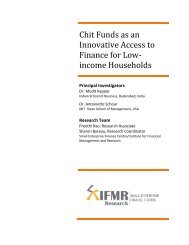Government of India Volume I: Analysis and Recommendations
Government of India Volume I: Analysis and Recommendations
Government of India Volume I: Analysis and Recommendations
Create successful ePaper yourself
Turn your PDF publications into a flip-book with our unique Google optimized e-Paper software.
FUNCTIONS AND POWERS OF THE REGULATOR<br />
Table <strong>of</strong> <strong>Recommendations</strong> 4.16 Approach to judicial review <strong>of</strong> regulatory actions<br />
1. All functions including the quasi-judicial function <strong>of</strong> regulator should be subject to judicial review;<br />
2. This review should be done through an appellate mechanism;<br />
3. There should be a single dedicated appellate tribunal for the entire financial sector that will cover all financial<br />
regulators;<br />
4. The appellate tribunal will hear appeals against the decisions made by <strong>and</strong> the regulations framed by financial<br />
regulators;<br />
5. The appellate tribunal will be funded by an appropriate fee from all regulated entities; <strong>and</strong><br />
6. The appellate tribunal’s structure is clearly detailed out in the draft Code.<br />
The Commission is <strong>of</strong> the opinion that while the entire Code for Civil Procedure, 1908<br />
(CPC) need not be followed by the administrative law <strong>of</strong>ficers <strong>and</strong> members, the draft<br />
Code provides the basic rubric <strong>of</strong> the procedure <strong>of</strong> judicial determination <strong>and</strong> appeals.<br />
Therefore, it will be the responsibility <strong>of</strong> the board <strong>of</strong> the regulator to create appropriate<br />
subsidiary legislation to establish the procedures to be followed for the discharge <strong>of</strong><br />
administrative law functions by the regulator.<br />
4.3.3. Judicial review <strong>and</strong> appellate tribunals<br />
The Commission recognises that actions taken by regulators can impose significant penalties<br />
<strong>and</strong> burden on regulated entities. Therefore, the rule <strong>of</strong> law requires that a clear judicial<br />
process be available to persons who seek to challenge regulatory actions. The needs<br />
<strong>of</strong> a modern financial system require us to move beyond a system where appeals against<br />
regulatory decisions can be made to an authority within the regulator or to the <strong>Government</strong><br />
to the creation <strong>of</strong> a specialised FSAT. The appellate framework envisaged by the<br />
Commission is outlined in Table 4.16.<br />
4.3.4. Structure <strong>of</strong> the appellate tribunal<br />
As regards the structure <strong>and</strong> functioning <strong>of</strong> the FSAT, the Commission finds that there is<br />
need for clearly demarcating <strong>and</strong> concentrating on two important functions:<br />
1. Judicial functions <strong>of</strong> the tribunal, which require persons with qualification <strong>and</strong> experience in law<br />
<strong>and</strong> finance; <strong>and</strong><br />
2. Administrative functions <strong>of</strong> the tribunal, which include service <strong>of</strong> documents, collecting evidence,<br />
accepting written submissions, managing dates for hearings <strong>and</strong> arguments.<br />
The judicial functions <strong>of</strong> the tribunal requires expertise in various fields <strong>of</strong> law <strong>and</strong> finance.<br />
In order to satisfy the requirements <strong>of</strong> separation <strong>of</strong> powers envisaged in the Constitution,<br />
the Commission recommends that the tribunal must remain under the control<br />
<strong>of</strong> judicial <strong>of</strong>ficers. This is also consistent with the present structure <strong>of</strong> tribunals in <strong>India</strong>.<br />
Table 4.17 summarises the recommendations <strong>of</strong> the Commission in relation to the judicial<br />
functions <strong>of</strong> the appellate tribunal.<br />
4.3.5. Functioning <strong>of</strong> the tribunal’s registry<br />
The present systems <strong>of</strong> management <strong>of</strong> courts <strong>and</strong> tribunals <strong>of</strong>ten involve m<strong>and</strong>ating<br />
the chief judicial <strong>of</strong>ficer <strong>of</strong> the court or the senior-most judge to be responsible for the<br />
administration <strong>of</strong> the tribunal or court. This can interfere with the person’s core appellate<br />
functions by causing him or her to divert attention to administrative matters. In some<br />
cases, this challenge has been addressed by appointing a separate registrar for the court<br />
or tribunal.<br />
The Commission recommends that the appellate tribunal should be supported by<br />
an efficient registry which will be headed by a registrar having specialised management<br />
FINANCIAL SECTOR LEGISLATIVE REFORMS COMMISSION 39



